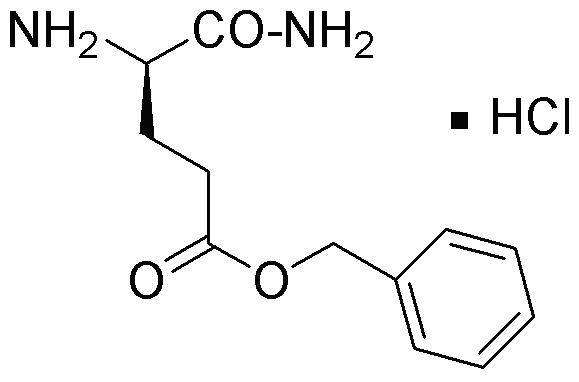D-Glutamic acid g-benzyl ester a-amide hydrochloride is widely utilized in research focused on:
- Pharmaceutical Development: This compound serves as a building block in the synthesis of various pharmaceuticals, particularly those targeting neurological disorders, due to its structural similarity to neurotransmitters.
- Biochemical Research: It is employed in studies examining amino acid metabolism and protein synthesis, helping researchers understand cellular functions and enzyme activities.
- Peptide Synthesis: The compound is used in the production of peptides, which are crucial for drug development and therapeutic applications, offering a versatile approach to modifying peptide structures.
- Food Industry: It can be used as a flavor enhancer or nutritional supplement, providing an alternative to traditional amino acids with potential benefits in taste and health.
- Cosmetic Formulations: This chemical is incorporated into skincare products for its moisturizing and skin-repairing properties, appealing to consumers seeking effective and gentle solutions.
General Information
Properties
Safety and Regulations
Applications
D-Glutamic acid g-benzyl ester a-amide hydrochloride is widely utilized in research focused on:
- Pharmaceutical Development: This compound serves as a building block in the synthesis of various pharmaceuticals, particularly those targeting neurological disorders, due to its structural similarity to neurotransmitters.
- Biochemical Research: It is employed in studies examining amino acid metabolism and protein synthesis, helping researchers understand cellular functions and enzyme activities.
- Peptide Synthesis: The compound is used in the production of peptides, which are crucial for drug development and therapeutic applications, offering a versatile approach to modifying peptide structures.
- Food Industry: It can be used as a flavor enhancer or nutritional supplement, providing an alternative to traditional amino acids with potential benefits in taste and health.
- Cosmetic Formulations: This chemical is incorporated into skincare products for its moisturizing and skin-repairing properties, appealing to consumers seeking effective and gentle solutions.
Documents
Safety Data Sheets (SDS)
The SDS provides comprehensive safety information on handling, storage, and disposal of the product.
Product Specification (PS)
The PS provides a comprehensive breakdown of the product’s properties, including chemical composition, physical state, purity, and storage requirements. It also details acceptable quality ranges and the product's intended applications.
Certificates of Analysis (COA)
Search for Certificates of Analysis (COA) by entering the products Lot Number. Lot and Batch Numbers can be found on a product’s label following the words ‘Lot’ or ‘Batch’.
Numéro de catalogue
Numéro de lot/série
Certificates Of Origin (COO)
This COO confirms the country where the product was manufactured, and also details the materials and components used in it and whether it is derived from natural, synthetic, or other specific sources. This certificate may be required for customs, trade, and regulatory compliance.
Numéro de catalogue
Numéro de lot/série
Safety Data Sheets (SDS)
The SDS provides comprehensive safety information on handling, storage, and disposal of the product.
DownloadProduct Specification (PS)
The PS provides a comprehensive breakdown of the product’s properties, including chemical composition, physical state, purity, and storage requirements. It also details acceptable quality ranges and the product's intended applications.
DownloadCertificates of Analysis (COA)
Search for Certificates of Analysis (COA) by entering the products Lot Number. Lot and Batch Numbers can be found on a product’s label following the words ‘Lot’ or ‘Batch’.
Numéro de catalogue
Numéro de lot/série
Certificates Of Origin (COO)
This COO confirms the country where the product was manufactured, and also details the materials and components used in it and whether it is derived from natural, synthetic, or other specific sources. This certificate may be required for customs, trade, and regulatory compliance.


